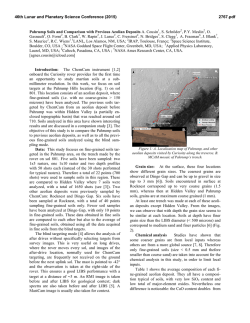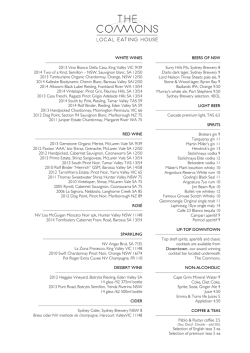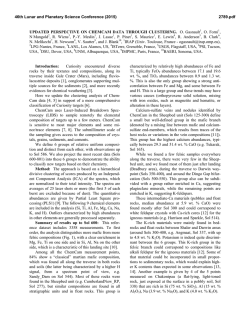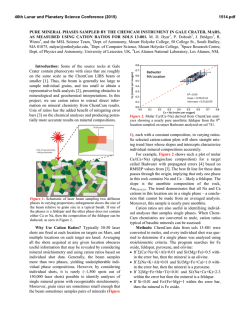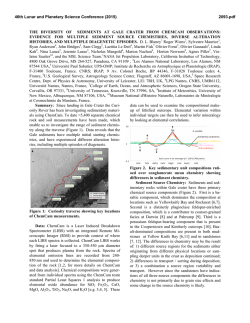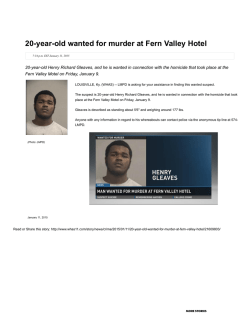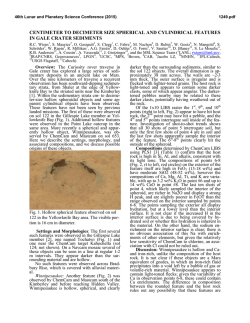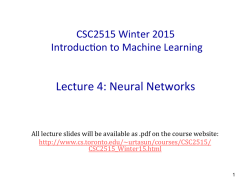
CHEMCAM SOIL ANALYSES – UNUSUALLY HIGH HYDROGEN IN
46th Lunar and Planetary Science Conference (2015) 2022.pdf CHEMCAM SOIL ANALYSES – UNUSUALLY HIGH HYDROGEN IN THE HIDDEN VALLEY SOILS AT GALE CRATER, MARS. S. Schröder1, A. Cousin1, P.-Y. Meslin1, O. Gasnault1, S. Maurice1, J. Lasue1, O. Forni1, N. Bridges2, B. Clark3, R.C. Wiens4, and the MSL Science Team. 1 Institut de Recherche en Astrophysique et Planétologie (IRAP), Toulouse, France. 2Applied Physics Laboratory, Laurel, MD, USA; 3 Space Science Institute, Boulder, CO, USA.4 Los Alamos National Laboratory, NM, USA. [[email protected]]. Introduction: The ChemCam suite [1, 2] on NASA’s Mars Science Laboratory (MSL) rover combines a Laser-Induced Breakdown Spectroscopy (LIBS) instrument with a Remote Micro-Imager (RMI), providing elemental analysis of soils and rocks together with pre- and post-LIBS context images of the target. One of the main advantages of LIBS is its ability to detect light elements such as hydrogen, which may indicate the presence of water, a key criterium for habitability. Hydrogen is observed in essentially all sedimentary and soil targets, usually with lower signal intensity in rocks than in the soils [3, 4]. A hydrated dust layer appears to cover the martian landscape, as documented by analysis of the first shots in multi-shot (typically 30 laser pulses) ChemCam spectra acquisition [5, 6]. In this study, we present ChemCam data obtained in a sandy-floored valley, informally named Hidden Valley by the MSL team, which showed the highest H signal measured with ChemCam up to date. ChemCam Hidden Valley soil investigations: On sol 705 of the mission, MSL went into the sandyfloored Hidden Valley close to the foothills of Mount Sharp, see Fig. 1. However, the sand in Hidden Valley was found to have more slip than expected [7] and therefore MSL reversed and left Hidden Valley on Sol 714. On sol 719 the rover returned again to the entry area of Hidden Valley. Between sol 705 and sol 720 several ChemCam measurements of the fine-grained soils in Hidden Valley were done: six Blind Targets of undisturbed and disturbed soil, i.e. moved by the rover wheels, were hit. “Blind targets” (BTs) are defined as targets observed by ChemCam on the right side of MSL after the rover has moved and information such as new images and the relative position of potential targets are not yet available for planning the next sol activities [8]. Moreover, three times the soil was targeted on purpose for further investigation of the sand (target names: Saline Valley, Redlands, Desert Range). For the latter additional dark spectra were taken before the LIBS laser was fired to enable the study of the 1stshot single-spectra complementary to the blind target data [9]. Images of all these soils taken with MastCam are shown in Fig. 2. In a companion study [10] the Hidden Valley soils are compared to a recently investigated dune with fine- Figure 1: On Sol 705 MSL was located at the entry of the sandy-floored Hidden Valley which it entered in the following sols. Various ChemCam measurements of the soils in Hidden Valley and its entry area were done. grained soil at the Pahrump Hills as well as to two other Aeolian deposits, that were encountered before. Analysis and Discussion: The two soils, Saline Valley and Redlands, which were both investigated on sol 707, consist of coarser grains on the surface on the order of 0.5 - 1 mm. In particular the disturbed soils at Hidden Valley are very fine grained and let to the formation of well visible craters. Many spectra obtained from the fine-grained soil in Hidden Valley feature an exceptionally high hydrogen signal with an averaged H signal-to-background ratio (SBR) of 2.02 ± 0.43 obtained from shots 6 to 30 in comparison to the fine-grained soils encountered before along the traverse with a mean H SBR of 1.61 ± 0.46. The spectrum with the highest H SBR measured so far with ChemCam on Mars was obtained from a 1 x 20 raster on Sol 711 in Hidden Valley where the mast did not move after the first measurement. Therefore, the second sequence of 30 shots was targeted on the same position as the first sequence, leading to a total of 60 shots on the same spot. The high hydrogen signal (H SBR 3.48) was obtained from this second sequence of 30 shots, i.e. the high hydrogen signal was not obtained from the surface but from a greater depth than usually sampled with ChemCam. Moreover, this soil was a disturbed soil where the sand was moved by the rover wheels on the sol before. 46th Lunar and Planetary Science Conference (2015) 2022.pdf Figure 2: In Hidden Valley the more or less fine-grained soil was investigated six times: three times it was targeted on purpose and three times the blind target modus hit the soil on the right side of the rover. Two of these soils were disturbed by the rover wheels. For blind target BT 711 the mast did not move after the first position, leading to a total of 2x 30 laser-shots on one position and thus, sampling the soil to a greater depth than usual. Overall, the disturbed soils investigated in Hidden Valley featured a significantly enhanced hydrogen signal with a mean H SBR of 2.21 ± 0.34 obtained from shots 6 to 30, while the undisturbed soils were found to have lower H SBR of 1.70 ± 0.35 which, however, is still higher than from the soils encountered before. This led to the conclusion that the high H is obtained from the soil in some mm depth and not from the very surface. As typical for the fine soils encountered on Mars [4] also the soils encountered in Hidden Valley show on average a typically basaltic composition with reduced Si content. The Partial Least Squares (PLS) predictions for Hidden Valley resulted in even slightly lower SiO2 values (on average 33.5%) and a lower sum of majorelement total oxides (on average 68.4%) for the targets inside Hidden Valley than typical for the fine soils along the traverse (34.7% and 70.3%, respectively). This may be due to a higher presence of minor and trace elements in the Hidden Valley soils compared to those encountered before, as only major elements are quantified by PLS. The Hidden Valley data was analyzed with univariate and multivariate methods in order to find correlations of H with other major, minor, and trace elements. However, a clear correlation with one single element was not found. Some of the high hydrogen data obtained in Hidden Valley have an enhanced signal of Ca, in particular in the disturbed soils. Moreover, the averaged Ca/Si ratio obtained from PLS was found to be slightly enhanced in the Hidden Valley soils, too. Na and K were found to correlate with each other in the Independent Component Analysis (ICA). Univariate analysis of the chlorine emission line at 837 nm showed that a higher Cl signal is obtained from the Hidden Valley soils in comparison to the overall blind-target soils. A Pearson correlation coefficient of 0.42 was obtained for this Cl signal and the H SBR, indicating a weak correlation of both elements. Sr and Cr obtained from univariate analysis are similar in all soils, however, slightly enhanced in Hidden Valley whereas Mn is slightly reduced. Interpretation: Possible interpretations of these results include the presence of salts such as chlorides or perchlorates in hydrated forms although no strong correlation with a major element was found. The very fine-grained H and Cl rich soils could also be the result of airfall deposits, which would, however, not explain the enhanced Ca signal in the ChemCam data. Acknowledgement: This work was supported by the Centre National d’Etudes Spatiales (CNES), France and by NASA’s Mars Exploration Program. Mars operations were provided by JPL-Caltech. References: [1] Maurice et al., Space Sci Rev, Vol 170, Issue 1-4, pp. 95-166, 2012. [2] Wiens et al., Space Sci Rev, Vol 170, Issue 1-4, pp. 167-227, 2012. [3] Schröder et al., Icarus, in press. [4] Cousin et al., Icarus, in press. [5] Meslin et al., Science 341, 2013. [6] Lasue et al., LPSC, #1224, 2014. [7] Fraeman et al., this meeting, 2015. [8] Cousin et al., LPSC, #1278, 2014. [9] Schröder et al., LPSC, #1928, 2014. [10] Cousin et al., this meeting, 2015.
© Copyright 2025
